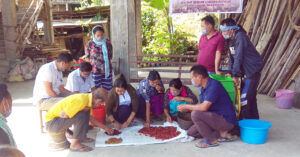Khar, November 11 (MTNews): A Quality Awareness Program (QAP) for coffee growers was held on November 10 at Khar village by the Senior Liaison Office, Coffee Board, Mokokchung with the goal of producing good quality coffee at the estate level and ensuring a good price at the farm gate.

Sentiyangla, EI, Coffee Board, Mokokchung exhorted the growers that the major portion of coffee produced in India is exported to developed countries that impose stringent quality standards.
She also stated that this year, the private sector interacted with coffee growers directly and purchased coffee at the farm gate based on quality, but the coffee could have received higher prices had there been better post-harvest protocol, with high moisture content being one of the most noticeable defects.
As a result, farm-level post-harvest practices play a critical role in preserving/enhancing intrinsic quality as well as microbial contaminants in coffee by observing good agricultural practices and plant protection practices.
During the technical session, the EI demonstrated that coffee processing is nothing more than obtaining marketable coffee seeds and is accomplished through two methods: a) the dry or natural method, which is used for cherry coffee, and b) the wet or washed method, which is used for parchment coffee.
She also stated that in general, Arabica coffee is primarily processed wet, whereas Robusta coffee is primarily processed dry. Harvesting of fruits at the appropriate stage of ripeness, sorting (green/overripe), pulping (removal of fruit skin/floats) which must be done immediately after harvest, de-mucilization (removal of mucilage), washing, soaking, sun drying of parchment (7-10 days under bright weather conditions), winnowing, conditioning, bagging, and storing are all steps involved in the wet method.
Meanwhile, the dry method involves harvesting, sorting (greens/unripe), drying of fruits (12-15 days under bright sunny weather conditions), winnowing, bagging, and storing. She advised that drying should be done only in a clean, tiled or concrete drying yard, and that if a pucca drying yard is not available, parchment should be dried in polythene or tarpaulin.
She also stated that the recommended moisture level after drying for Parchment is 10.5% and 11% for cherry coffee, which can be tested with a moisture meter. Bags should be stored on raised wooden platforms and kept in well-ventilated stores. Cherry and parchment coffee should not be stored together, nor should other materials such as fertilizers and pesticides.
L Temsu , Asst. Inspector , LRD, Mokokchung also stated that coffee quality can be achieved by doing the right things at the right time, and that coffee harvesting and processing is both an art and a science. He exhorted that it should be a source of great pride and joy for a grower to contribute to the production of good-quality coffee.
Along with the program, Swachhta Pakhwada, awareness on COVID protocols was also observed where masks/hand sanitizers/ dustbin were distributed. Altogether 30 numbers of participants attended the program. The growers thanked the Deputy Director (Ext) Coffee Board, Jorhat for arranging such practical oriented training program and conveyed that similar program on different topics be conducted in the future to enrich their knowledge in coffee. Leaflets/ brochures related to the post harvest management in coffee were distributed to the growers for future reference.



